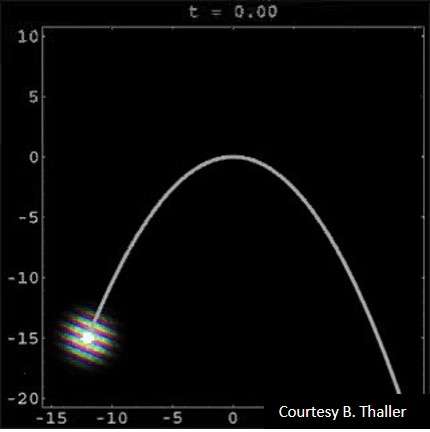As the picture indicates, the quantum wave closely follows the classical particle on average. Credit: B. Thaller
The global scientific society Institute of Physics recently announced that their editors selected a research article by a team from Chapman University's Institute for Quantum Studies "for inclusion in the exclusive 'Highlights of 2013' collection." The paper, titled, "The classical limit of quantum optics: not what it seems at first sight," was originally published in the New Journal of Physics last year. This paper proposed a revolutionary new way to understand the relationship between the microscopic and macroscopic scales of nature – in other words the relationship between objects which are large enough to be visible with the naked eye vs. objects only "visible" using high-powered magnifying devices such as types of microscopes.
"The microscopic quantum realm of atoms and particles is so strange and different from the reality we experience at a human - or visible – scale, that it is almost impossible to picture the reality at the quantum scale," noted Jeff Tollaksen, Ph.D., one of the authors of the paper and co-director of Chapman's Institute for Quantum Studies.
"For example, individual particles at the quantum (or microscopic) scale can seem to hover in many different places at once. That is, many mutually exclusive possibilities seem to be simultaneously co-existent at the quantum scale. Even though everything around us at the macro or visible level is created out of these same atoms, nevertheless our experience of the macro level doesn't look anything like the quantum scale: i.e., we seem to always be in a definite location in spectacular contrast to the quantum reality," continued Dr. Tollaksen.
While scientists are still struggling to understand how all this "quantum weirdness" seems to disappear when bigger things are considered, the scientific community agrees that the transition from micro to macro occurs in a smooth way with no big surprises.
The Chapman team showed for the first time that this belief that the transition from microscopic to macroscopic scales is 'smooth' was dramatically not true. As a result, they argued that a complete revision of all intuitions and theories concerning this important relationship was required.
According to the paper: "Inventing a new theory of nature requires, as the [legendary] physicist Richard Feynman said, 'imagination in a terrible strait-jacket.' Unlike the artist, who need not obey constraints, scientists are not free to imagine whatever they want - the new theory must obey a 'correspondence principle'."
"It must, obviously, give different predictions than the old theory for some phenomena, but at the same time it must agree with the old theory in all the places in which the old theory was already experimentally verified. For all those experiments the new theory must give numerical results that are very similar to those of the old theory. Historically, the story told by the new theory relates in rather simple ways to the story of the old theory," the paper continues.
"Even the classical limit of quantum mechanics (seems to be) rather benign - with increasing mass, wavepackets [the localized field of waves surrounding a mass] become narrower and narrower yet they will take longer and longer to spread, so particles can be better localized. Wavepackets will then follow trajectories very close to the classical ones." the paper maintains.
The Chapman team showed, however, that this benign behavior is only an illusion: the classical limit of quantum mechanics tells a conceptual story that is dramatically different from that of classical physics. The implications of this discovery are far reaching.
Journal information: New Journal of Physics
Provided by Chapman University























